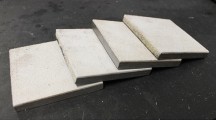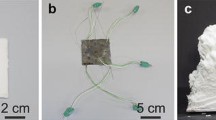Abstract
This paper reports the results of an experimental study on fire protection performance of intumescent coatings exposed to three non-standard fire curves. Intumescent coatings were applied to steel plates to make test specimens and, in total, furnace tests were performed on 36 specimens. The effective thermal conductivities of the intumescent coatings were calculated based on the measured steel and furnace temperatures. Scanning electron microscopy (SEM) tests were conducted to give some information on the difference in inner structure of intumescent char. Results of the experimental studies reveal that the fire protection performance of intumescent coating is highly dependent on the heating rate and maximum temperature of the fire condition. Different pore structures of the intumescent chars were obtained when intumescent coatings were subjected to fires with varied heating rates. The reaction steps of intumescent coating underwent depended on the maximum temperature of the fire condition. The consequence of this is changed expansion ratio and inner structure of intumescent char and then different effective thermal conductivity. When subjected to non-standard fire I, the reaction process of intumescent coating was incomplete and no “honeycomb” pore structure was observed; in comparison, the coating underwent complete reaction process and compact “honeycomb” pore structure was obtained when exposed to non-standard fire III; the maximum difference for representative values of effective thermal conductivities was up to 48.8%. In addition, due to the peculiar flame retardant mechanism of the intumescent coating, increasing the coating thickness does not always yield insulating property benefit.













Similar content being viewed by others
References
Dowling J (2003) Fire protection costs for structural steelwork. New Steel Construction (UK). Sep/Oct, pp 8–9
Bourbigot S, Duquesne S, Leroy JM (1999) Modeling of heat transfer of a polypropylene-based intumescent system during combustion. J Fire Sci 17:42–56
Gillet M, Autrique L, Perez L (2007). Mathematical model for intumescent coatings growth: application to fire retardant systems evaluation. J Phys D 40:883–899
Wang Y, Goransson U, Holmstedt G et al (2006) A model for prediction of temperature in steel structure protected by intumescent coating based on tests in cone calorimeter, fire safety science-proceedings of the eighth international symposium, pp 235–246
International Standards Organization (ISO) (1975) ISO834: Fire Resistance Tests- Elements of Building Construction, Geneva
Li GQ, Wang PJ (2012) Advanced analysis and design for fire safety of steel structures. Zhejiang University Press, Hangzhou
Anderson CE, Ketchum DE, Mountain WP (1988) Thermal conductivity of intumescent chars. J Fire Sci 16:390–410
Jimenez M, Duquesne S, Bourbigot S (2006). Characterization of the performance of an intumescent fire protective coating. Surf Coat Technol 201:979–987
Li GQ, Zhang C, Lou GB et al (2012) Assess the fire resistance of intumescent coatings by equivalent constant thermal resistance. Fire Technol 48:529–546
Bartholmai M, Schriever R, Schartel B (2003). Influence of external heat flux and coating thickness on the thermal insulation properties of two different intumescent coatings using cone calorimeter and numerical analysis. Fire Mater 27:151–162
Wang LL, Wang YC, Li GQ (2013). Experimental study of hydrothermal aging effects on insulative properties of intumescent coating for steel elements. Fire Saf J 55:168–181
Griffin GJ (2010) The modeling of heat transfer across intumescent polymer coatings. J Fire Sci 28:249–277
Zhang Y, Wang YC, Bailey CG et al (2012) Global modeling of fire protection performance of intumescent coating under different cone calorimeter heating conditions. Fire Saf J 50:51–62
Yuan JF (2009) Intumescent coating performance on steel structures under realistic fire conditions. PhD thesis, University of Manchester
McGrattan KB, Hostikka S, McDermott R, Floyd J, Weinschenk C, Overholt K (2013) Fire dynamic simulator (user’s guide), 6th edn. NIST Special Publication 1019
China Association for Engineering Construction Standardization (CECS200) (2006) Technical code for fire safety of steel structure in buildings (in Chinese). China Planning Press, Beijing
Du Y (2007) A practical approach for fire resistance design of large space building grid structures. PhD thesis, Tongji University
European Committee for Standardization (2005) ENV1993-1-12, Eurocode 3, Design of Steel Structures, Part 1.2, General Rules-Structural Fire Design, BSI, London
Wang LL, Wang YC, Yuan JF, Li GQ (2013) Thermal conductivity of intumescent coating char after accelerated aging. Fire Mater 37:440–456
Acknowledgments
This research is funded by the National Natural Science Foundation of China through the contract 51308237 and a research Grant (2014J01198) from Fujian province.
Author information
Authors and Affiliations
Corresponding authors
Rights and permissions
About this article
Cite this article
Wang, L., Dong, Y., Zhang, C. et al. Experimental Study of Heat Transfer in Intumescent Coatings Exposed to Non-Standard Furnace Curves. Fire Technol 51, 627–643 (2015). https://doi.org/10.1007/s10694-015-0460-7
Received:
Accepted:
Published:
Issue Date:
DOI: https://doi.org/10.1007/s10694-015-0460-7




